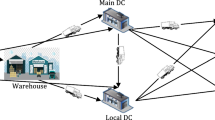Abstract
The development of fully integrated supply chain networks has drawn much attention due to industrial integration and globalization. Inter-plant transportation of chemicals plays a central role in enabling efficient supply chains and eco-industrial parks. The transported materials often include hazardous material (HazMat) for which safety is a major concern. This paper presents a HazMat transportation model that considers both economic and safety objectives. The study uses historical incident data for HazMat from the U.S Department of Transportation (USDOT) to quantify the transportation risk, and the epsilon-constraint method is then applied to integrate risk into the optimization framework. A case study was conducted for methanol transportation using both highway and railroad. The results of this study illustrate a Pareto optimal curve that shows the trade-off between transportation cost and risk. By solving the optimization problem, the optimum transportation cost at each discretized risk value can be determined, and the two objectives can be correlated for further decision-making. The HazMat transportation model provides a flexible framework to integrate more factors into the traditional transportation or material allocation problem in the future.












Similar content being viewed by others
References
Abkowitz M, Cheng PDM (1988) Developing a risk/cost framework for routing truck movements of hazardous materials. Accid Anal Prev 20(1):39–51
Centers for Disease Control and Prevention (2017) Methanol. https://www.cdc.gov/niosh/ipcsneng/neng0057.html. Accessed September 2017
Chew IML, Tan R, Ng DKS, Foo DCY, Majozi T, Gouws J (2008) Synthesis of direct and indirect interplant water network. Ind Eng Chem Res 47(23):9485–9496
El-Halwagi MM (2017a) A shortcut approach to the multi-scale atomic targeting and design of C-H-O symbiosis networks. Process Integration and Optimization for Sustainability 1(1):3–13
El-Halwagi MM (2017b) Sustainable design through process integration: fundamentals and applications to industrial pollution prevention, resource conservation, and profitability enhancement. Elsevier, Second Edition
Erkut E, Tjandra SA, and Verter V (2007) Hazardous materials transportation. Handbooks in operations research and management science, 14, 539–621
Federal Railroad Administration (2014) Office of safety analysis. http://safetydata.fra.dot.gov/OfficeofSafety/default.aspx. Accessed December 2014
Gebauer M, Jordan J (2002) Methanol market distribution infrastructure in the United States. Prepared for methanol institute. Washington, DC
Harwood DW, Viner JG, Russell ER (1993) Procedure for developing truck accident and release rates for hazmat routing. J Transp Eng 119(2):189–199
Huang B, Fery P (2005) Aiding route decision for hazardous material transportation. Transp Res Board 2005
Jordan J, Associates (2013) Global methanol report. Argus Media, Issue:13–15
Kang Y, Batta R, Kwon C (2014) Value-at-risk model for hazardous material transportation. Ann Oper Res 222(1):361–387
Kazantzi V, Kazantzis N, Gerogiannis VC (2011) Risk informed optimization of a hazardous material multi-periodic transportation model. J Loss Prev Process Ind 24(6):767–773
Meng Q, Lee DH, Cheu RL (2005) Multiobjective vehicle routing and scheduling problem with time window constraints in hazardous material transportation. J Transp Eng 131(9):699–707
National Highway Traffic Safety Administration. Traffic safety facts (2012) https://crashstats.nhtsa.dot.gov/Api/Public/ViewPublication/812032, accessed December 2014
PHMSA—HazMat Incident Report Search website (2017). http://phmsa.dot.gov/hazmat/library/data-stats/incidents. Accessed March 2017
Samuel C, Keren N, Shelley MC, Freeman SA (2009) Frequency analysis of hazardous material transportation incidents as a function of distance from origin to incident location. J Loss Prev Process Ind 22(6):783–790
Transportation Statistics Annual Report (2015) https://www.rita.dot.gov/bts/sites/rita.dot.gov.bts/files/TSAR_2015_final_0.pdf. Accessed December 2014
Zhang J, Hodgson J, Erkut E (2000) Using GIS to assess the risks of hazardous materials transport in networks. Eur J Oper Res 121(2):316–329
Funding
This publication was made possible by NPRP grant no. 7-724-2-269 from the Qatar National Research Fund (a member of Qatar Foundation). The statements made are solely the responsibility of the authors.
Author information
Authors and Affiliations
Corresponding author
Ethics declarations
Conflict of Interest
The authors declare that they have no conflict of interest.
Rights and permissions
About this article
Cite this article
Zhang, C., Nguyen, C., Eljack, F. et al. Integration of Safety in the Optimization of Transporting Hazardous Materials. Process Integr Optim Sustain 2, 435–446 (2018). https://doi.org/10.1007/s41660-018-0063-0
Received:
Revised:
Accepted:
Published:
Issue Date:
DOI: https://doi.org/10.1007/s41660-018-0063-0




